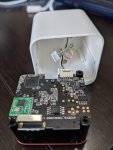Danny37
Member
I installed a wyze v3 camera about a month ago after I had a package stolen. The camera is installed about 5 feet away from my outdoor antenna. I know, probably not a good idea but my antenna is fixed to an old TV antenna mount, the camera sits about 5 feet below it. Its causing my scanners and even my radios to pick up interference. I know its camera cause when i unplug it from the wall, the interference goes away. But when I turn off the camera with the app (still plugged in) the interference is still there. I switched out the wall adapter for a heavier duty one and still RF. Now, I don't know what is causing the interference. Is it the wifi 2.4ghz signal? Is it the micro usb cable? Is it the wall adapter? or a combination of the three?
I should mention that the camera and my scanners are plugged into the electric outlets on opposite sides of the room, probably on the same circuit. I added a choke on the micro usb end that terminates to the wall plug and wrapped it several times and no luck there.
What can I do to solve this problem? I can probably install the camera a bit further away but that's about it. Do they made bnc RF noise reductions for the WIFI band?
I should mention that the camera and my scanners are plugged into the electric outlets on opposite sides of the room, probably on the same circuit. I added a choke on the micro usb end that terminates to the wall plug and wrapped it several times and no luck there.
What can I do to solve this problem? I can probably install the camera a bit further away but that's about it. Do they made bnc RF noise reductions for the WIFI band?
Last edited:


